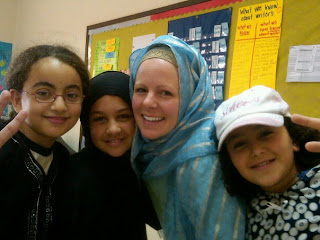The second holiday, Eid al-Adha is celebrated by Muslims to commemorate the willingness of Ibrahim (Abraham) to sacrifice his son, Ishmael, as an act of obedience to God. But then, as the story in the Quraan states, Allah intervened and asked Ibrahim to sacrifice a ram in place of his son. And to this day, Muslim families around the world take part in this sacrifice each year. Eid al-Adha is celebrated directly following the two week pilgrimage to Mecca, called Hajj that also happens annually.
"The Hajj (Arabic: حج Ḥajj) is the annual pilgrimage to Mecca, Saudi Arabia. It is currently the largest annual pilgrimage in the world,[1] and is the fifth pillar of Islam, a religious duty that must be carried out at least once in their lifetime by every able-bodied Muslim who can afford to do so. The Hajj is a demonstration of the solidarity of the Muslim people, and their submission to God (Allah in the Arabic language).[2]"
I believe to be very fortunate as I was able to witness a well produced simulation of Hajj. (Special because any man not of the muslim faith is not permitted to enter Mecca to observe these events at any time). The Arabic, Religion and Quraan teachers at Hayah developed an incredible event for our students to see first hand what it will be like to visit Mecca in their future. From the stamping of their "passports" at the "airport into Mecca" to circling the "Ka3ba" seven times. Each ritual observed at Hajj was also observed at Hayah's simulation (with only slight adjustments).
Here is the Hajj journey, Enjoy!!
Step 1- Wodu' (ablution): is the Islamic act of washing parts of the body using water. Muslims are required to be clean in preparation for ritual prayers.
This washing includes:
- Washing the face once.
- Washing both the arms including the elbows once.
- Performing masah of one fourth of the head.
- Wiping both the feet once up to and including the ankles.
Step 2- Putting on Ibrahim's clothes: All men should be dress exactly the same in white cloth, without trim, tied together over the heart. Women are allowed to wear what they choose as long as it covers every part of the body except their face and hands.
**Almost all students at this school are Muslim, with the exception of a few ex-pat teacher's children. My favorite is a first grader named Natalie. Her and her family are from Minnesota and have some strong midwestern roots:) She is a doll, full of life and loves to experience new things. Because of those attributes, she was the bravest of all ex-pat kids and decided to "participate" in the simulation. Natalie and her father, Steve, dressed in the traditional clothing and observed all the rituals with her classmates. It was so neat to watch her. A side note, these rituals are pretty intense, even for myself, as an adult, the chats, movements and uniform dress were pretty overwhelming. She was very brave to endure something so foreign to her.
Step 3- Prayer: Every Muslim in the elementary, both student and staff, lined facing east and began their prayer to Mecca.
Step 4- Passport Acceptance at Airport
Step 5- Tawaf Al-Qudoum (circumambulating): Circle the Ka3ba seven times in an counter-clockwise direction. During this time, three different Dua'a were recited together as a group.
For instance, the Dua'a recited when first seeing the Ka3ba: "Alahoma zed hatha al bayt tashrifan wa ta'ziman wa mahabatan wa refa'a"
 |
| The Ka3ba- Mohammad's home |
 |
| Ibrahim's footprints |
 |
| Abdel-Rahman (Taco) in traditional dress |
Step 6- Jabal Arafat (Arafat Mountain):
Pilgrims climb the mountain and stand in contemplative vigil and pray and recite the Qur'an, near a hill from which Muhammad gave his last sermon, this hill is called Jabal Al Rahmah (The Hill of Forgiveness, Mount Arafat). This is known as Wuquf, considered the highlight of the Hajj.
 |
| Collecting seven stones |
Step 7- Mennah / Mozdelafa: Each Muslim collects seven stones to throw at the Devil
The pilgrims leave Arafat for Muzdalifah, an area between Arafat and Mina, where they gather pebbles for the next day's ritual of the stoning of the Devil (Shaitan).
Step 8- Al Shahed: Stoning of the Devil
The Pilgrim says: "Allaho Akbar", then throws the seven small pebbles.
At Mina the pilgrims perform Ramy al-Jamarat, throwing stones to signify their defiance of the Devil. This symbolizes the trials experienced by Abraham while he was going to sacrifice his son as demanded by Allah. The Devil challenged him three times, and three times Abraham refused. Each pillar marks the location of one of these refusals
 |
| The "Devil" is inside the arch. |
 Step 9- Tawaf Al Ifada (Circumambulating): Circle the Ka3ba once more as the pilgrim says: "La Ilaha ila Allah wahdaho la sharika lah"
Step 9- Tawaf Al Ifada (Circumambulating): Circle the Ka3ba once more as the pilgrim says: "La Ilaha ila Allah wahdaho la sharika lah"On this or the following day the pilgrims re-visit the Masjid al-Haram mosque in Mecca for another tawaf, to walk around the Kaaba. This symbolizes being in a hurry to respond to God and show love for Him, an obligatory part of the Hajj.
Step 10- Sa'i between as-Safaa and al-Marwa: Walk between the as-Safa hill and al-Marwa hill.
The pilgrims perform sa`i, running or walking seven times between the hills of Safa and Marwah. This is a re-enactment of the frantic search for water for her son Ishmael by Abraham's wife Hagar. As she searched, the Zamzam Well was revealed to her by an angel, who hit the ground with his heel (or brushed the ground with the tip of his wing), upon which the water of the Zamzam started gushing from the ground.
 |
| The Route of Hajj |
 |
| 5th grade teacher, Marcy, and her son, Ali, after Hajj |







No comments:
Post a Comment